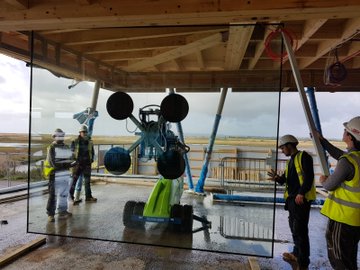As the huge glass panels were being installed in the Discovery Centre, we began to get much more of a sense of what the building will look like when it’s completed.
Baxall Construction have brought in the Sealtite Group for this, so we spoke to Will Chan, their Business Development Manager.
What does Sealtite do?

We work mainly in schools, commercial and residential sites, putting in windows, doors and ‘curtain walling’, which is what you get in shopfronts and screens which extend over more than one storey. We were so pleased to secure the contract for structural glazing from Baxall for the Discovery Centre project, because it’s such a lovely and interesting building to be involved with. Very well designed. It will look spectacular.
What is Sealtite’s role with the Discovery Centre?
We’ve been installing the solar-controlled, double-glazed units, each containing 23.5mm of overall glass thickness. A normal double-glazed window contains 8mm of glass. When you increase the size of a pane of glass, you must increase the thickness, for safety reasons. So if anyone fell against one of the units, there is less likelihood of it breaking.

‘Solar controlled’ means they limit the heat gain from the sun, so the building doesn’t overheat when it’s sunny. The glass is neutral coloured. The thicker the glass, the more of a tint you get. The larger panes are 3.4m tall and 1.9m across.
Baxall created concrete channels for our metal channels to sit in, to accommodate the glazing. We brought the glass panels on-site and structurally bonded them by silicone sealing them together with a joint width of about 6mm. To move and position each piece, we used a ‘vacuum lift’ (suction pads) on a glazing ‘robot’.
To put each glass unit into its channel, we use the ‘shuffle-glaze’ technique. We seal them using silicone, which when set is rubberised and flexible, so it can move. This allows for expansion, because glass will contract in the winter and expand in the summer.
How has it been going with such challenging weather?
We took into account how exposed the site is when we did the risk assessment for the project. The glass panes are so big they can literally act as sails when it’s very windy, so it’s been very challenging at times, but we’re used to that, and have been extremely careful.
Are you local? Have you visited the site yet?
Yes, I live in Kent. I haven’t been since the early days, but I definitely will be coming again.
How will we keep the windows clean?
You will need a regime for that, but they can be cleaned in the usual way, with extendable poles, the sort that are used for houses and businesses by window cleaners. You can’t use the “self cleaning” glass for this building. That needs rain to actually fall on the glass, which is less likely happen at the Discovery Centre because of the roof overhang.
Image Credits: Sealtite , Sussex Wildlife Trust .




How will they pay the window cleaners? Just a tiny example of the enormous annual maintenance costs of a building like this. And they say it won’t be hired out for functions.
What about birds flying into the glass panels? What steps have you taken to mitigate this issue?
Having lived in Rye for many years and walked every day either down the river or round the nature reserve, I was interested to read the article about the glass in the new discovery centre. It seems extraordinarily naive to say that rain won’t fall much on it as there is a roof overhang. Anyone living in these parts knows that most of the rain that falls here is very hard and salty and horizontal from the strong predominantly south west winds! The glass will need to be cleaned after every downpour as the sunshine that follows will show up all the salty raindrops! I agree with the first comment, either expensive professional cleaners needed or willing fit volunteers!
Mrs. R. Compton